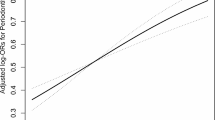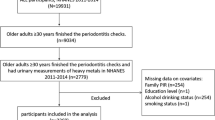Abstract
Objectives
We present data from the Korean National Health and Nutrition Examination Survey 2008–2009 regarding the association between blood lead and mercury levels and periodontitis in a representative sample of the adult South Korean population.
Methods
The analysis was restricted to participants ≥20 years of age who completed the health examination survey, including blood lead, cadmium, and mercury measurements (n = 3,966). Odds ratios (ORs) for periodontitis were calculated for log-transformed blood metal levels and quartiles thereof after covariate adjustment.
Results
In a logistic regression analysis using log-transformed blood lead and mercury levels as independent variables after covariate adjustment, including blood lead, mercury, and cadmium, the ORs and 95 % CI values in men for having periodontitis with doubling of blood lead and mercury were 1.699 (1.154–2.503) and 1.394 (1.057–1.838), respectively. Furthermore, in a logistic regression analysis using tertiles of blood lead and mercury as independent variables after covariate adjustment, the ORs and 95 % CIs of men for having periodontitis in the highest tertile were 1.756 (1.184–2.604) and 1.575 (1.507–2.347), respectively. ORs in the logistic regression analysis for men using log-transformed blood cadmium or the tertile of blood cadmium as independent variables after covariate adjustments were not statistically significant in either model. Unlike men, ORs in the logistic regression analyses for women using the same independent variables after covariate adjustment were not statistically significant in any blood metal analysis.
Conclusions
The association between blood lead and mercury levels and periodontitis was significant regardless of the type of variable (continuous or categorical) in the Korean male population.
Similar content being viewed by others
References
Albandar JM, Brunelle JA, Kingman A (1999) Destructive periodontal disease in adults 30 years of age and older in the United States, 1988–1994. J Periodontol 70:13–29
Bolewska J, Holmstrup P, Moller-Madsen B, Kenrad B, Danscher G (1990) Amalgam associated mercury accumulations in normal oral mucosa, oral mucosal lesions of lichen planus and contact lesions associated with amalgam. J Oral Pathol Med 19:39–42
Centers for Disease Control and Prevention (CDC) Fourth national report on human exposure to environmental chemicals. CDC, 2009 Available at: http://www.cdc.gov/exposurereport. Accessed May 24 2012
Dye BA, Hirsch R, Brody DJ (2002) The relationship between blood lead levels and periodontal bone loss in the United States. Environ Health Perspect 110:997–1002
El-Said KF, El-Ghamry AM, Mahdy NH, El-Bestawy NA (2008) Chronic occupational exposure to lead and its impact on oral health. J Egypt Public Health Assoc 83:451–466
Freden H, Hellden L, Milleding P (1974) Mercury content in gingival tissues adjacent to amalgam fillings. Odontol Revy 25:207–210
Genco RJ (1996) Current view of risk factors for periodontal diseases. J Periodontol 67:1041–1049
Han DH, Lim SY, Sun BC, Janket SJ, Kim JB, Paik DI, Paek D, Kim HD (2009) Mercury exposure and periodontitis among a Korean population: the Shiwha-Banwol environmental health study. J Periodontol 80:1928–1936
Jarup L (2003) Hazards of heavy metal contamination. Br Med Bull 68:167–182
Korean Center of Disease Center, Ministry of Health and Welfare (2009) Korean national health and examination surveys: the 4th surveys, 2007. Available at: http://knhanes.cdc.go.kr. Accessed December 9 2009
Landrigan PJ (1982) Occupational and community exposures to toxic metals: lead, cadmium, mercury and arsenic. West J Med 137:531–539
Lee BK, Kim Y (2012) Iron deficiency is associated with increased levels of blood cadmium in the Korean general population: analysis of the 2008–2009 Korean National Health and Nutrition Examination Survey data. Environ Res 112:155–163
Li P, He L, Sha YQ, Luan QX (2009) Relationship of metabolic syndrome to chronic periodontitis. J Periodontol 80:541–549
Liu Y, Cotgreave I, Atzori L, Grafstrom RC (1992) The mechanism of Hg2+ toxicity in cultured human oral fibroblasts: the involvement of cellular thiols. Chem Biol Interact 85:69–78
Lockitch G (1993) Perspectives on lead toxicity. Clin Biochem 26:371–381
Mozaffarian D, Rimm EB (2006) Fish intake, contaminants, and human health: evaluating the risks and the benefits. JAMA 296:1885–1899
Offenbacher S (1996) Periodontal diseases: pathogenesis. Ann Periodontol 1:821–878
Pineda-Zavaleta AP, Garcia-Vargas G, Borja-Aburto VH et al (2004) Nitric oxide and superoxide anion production in monocytes from children exposed to arsenic and lead in region Lagunera, Mexico. Toxicol Appl Pharmacol 198:283–290
Pinkerton LE, Biagini RE, Ward EM et al (1998) Immunologic findings among lead exposed workers. Am J Ind Med 33:400–408
Pounds JG, Long GJ, Rosen JF (1991) Cellular and molecular toxicity of lead in bone. Environ Health Perspect 91:17–32
Reichl FX, Esters M, Simon S et al (2006) Cell death effects of resin-based dental material compounds and mercurials in human gingival fibroblasts. Arch Toxicol 80:370–377
Saito T, Shimazaki Y, Koga T, Tsuzuki M, Ohshima A (2001) Relationship between upper body obesity and periodontitis. J Dent Res 80:1631–1636
Saraiva MC, Taichman RS, Braun T, Nriagu J, Eklund SA, Burt BA (2007) Lead exposure and periodontitis in US adults. Periodontal Res 42:45–52
Shenker BJ, Pankoski L, Zekavat A, Shapiro IM (2002) Mercury-induced apoptosis in human lymphocytes: caspase activation is linked to redox status. Antioxid Redox Signal 4:379–389
Silbergeld EK, Sauk J, Sommerman M et al (1993) Lead in bone: storage site, exposure source, target organ. Neurotoxicology 14:225–236
Williams RC (1990) Periodontal disease. N Engl J Med 322:373–382
Conflicts of interest
The authors declare they have no conflicts of interest.
Author information
Authors and Affiliations
Corresponding author
Rights and permissions
About this article
Cite this article
Kim, Y., Lee, BK. Association between blood lead and mercury levels and periodontitis in the Korean general population: analysis of the 2008–2009 Korean National Health and Nutrition Examination Survey data. Int Arch Occup Environ Health 86, 607–613 (2013). https://doi.org/10.1007/s00420-012-0796-y
Received:
Accepted:
Published:
Issue Date:
DOI: https://doi.org/10.1007/s00420-012-0796-y




